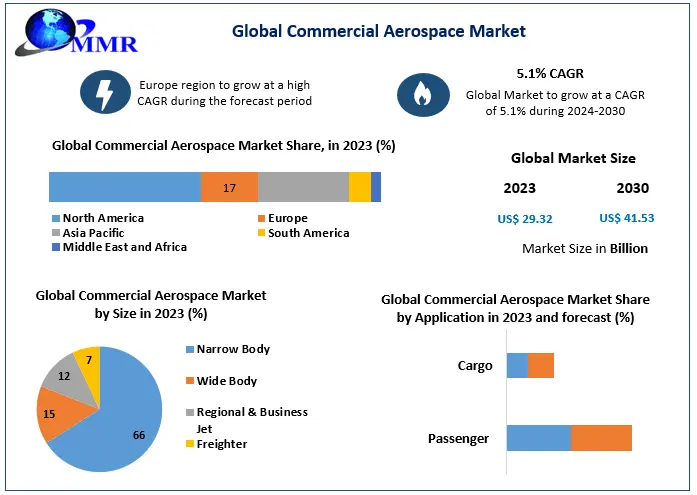Future of Flight: Commercial Aerospace Market Trends and Forecast 2024-2030

Introduction
The Commercial Aerospace Market is undergoing a transformative phase, driven by rapid technological advancements, increasing global travel demand, and innovations in aircraft manufacturing. As airlines strive for fuel efficiency and environmental sustainability, aerospace companies are investing heavily in next-generation aircraft, hybrid propulsion systems, and enhanced passenger experiences. This blog explores the key trends shaping the commercial aerospace industry, its segmentation, major players, and the future outlook of the market.
Click Here For Free Sample Report Link:https://www.maximizemarketresearch.com/request-sample/201515/
Market Segmentation
The commercial aerospace market can be broadly segmented based on aircraft type, component, end-user, and region.
1. By Aircraft Type
-
Narrow-body Aircraft: Dominating short- to medium-haul routes, favored for fuel efficiency and cost-effectiveness.
-
Wide-body Aircraft: Used in long-haul international flights, offering higher passenger capacity.
-
Regional Jets: Ideal for smaller markets and short-haul destinations.
-
Freighter Aircraft: Essential for the growing e-commerce and cargo transportation industry.
2. By Component
-
Engines: Advanced propulsion systems focusing on efficiency and emissions reduction.
-
Avionics: Innovations in cockpit technology, automation, and cybersecurity.
-
Aerostructures: Lightweight composite materials replacing traditional metals to improve fuel efficiency.
-
Cabin Interiors: Enhanced in-flight experience with smart seating, connectivity, and entertainment solutions.
3. By End-User
-
Commercial Airlines: The primary drivers of market demand, constantly upgrading fleets.
-
Leasing Companies: Facilitating aircraft financing and flexible fleet management.
-
Cargo Operators: Expanding operations due to the rise in e-commerce and global trade.
4. By Region
-
North America: Home to major aerospace manufacturers and technology leaders.
-
Europe: Focused on sustainability and eco-friendly aircraft innovations.
-
Asia-Pacific: Fastest-growing aviation market due to increasing air travel demand.
-
Middle East & Africa: A hub for long-haul travel and airline expansions.
Key Trends Shaping the Commercial Aerospace Market
1. Sustainability & Green Aviation
Aerospace companies are investing in sustainable aviation fuels (SAF), electric and hybrid propulsion, and carbon offset programs to reduce the environmental impact of air travel.
2. Increased Production of Next-Gen Aircraft
Leading aircraft manufacturers, including Boeing and Airbus, are ramping up production of fuel-efficient models such as the Boeing 737 MAX and Airbus A320neo to meet rising demand.
3. Digital Transformation & Smart Manufacturing
The adoption of AI, IoT, and predictive maintenance is enhancing aircraft manufacturing, reducing downtime, and improving operational efficiency.
4. Growing Demand for Urban Air Mobility (UAM)
Companies are developing electric vertical takeoff and landing (eVTOL) aircraft, aiming to revolutionize urban transport and reduce congestion in megacities.
5. Post-Pandemic Recovery & Increased Air Travel Demand
With air travel rebounding, airlines are expanding fleets and modernizing aircraft to cater to evolving passenger preferences.
More Insights Of Full Report In Details:https://www.maximizemarketresearch.com/market-report/commercial-aerospace-market/201515/
Key Players in the Commercial Aerospace Market
1. Boeing (U.S.)
One of the world’s largest aerospace manufacturers, Boeing produces commercial jets, defense systems, and space exploration technologies.
2. Airbus (Europe)
A leading competitor to Boeing, Airbus focuses on innovative and fuel-efficient aircraft such as the A320neo and A350 models.
3. Lockheed Martin (U.S.)
While primarily known for defense, Lockheed Martin contributes significantly to aerospace innovation and space exploration.
4. GE Aviation (U.S.)
A key player in aircraft engines and propulsion technologies, GE Aviation is at the forefront of sustainability efforts.
5. Safran (France)
This multinational company specializes in aircraft engines, landing gear, and avionics systems, supporting major aerospace OEMs.
6. Rolls-Royce Holdings (U.K.)
A leader in high-performance jet engines, Rolls-Royce is investing heavily in hybrid and electric aviation solutions.
7. Honeywell Aerospace (U.S.)
Known for avionics and aircraft systems, Honeywell is a major supplier of cockpit and safety technologies.
Conclusion
The commercial aerospace market is poised for exponential growth, driven by innovation, sustainability initiatives, and increasing global demand for air travel. As the industry moves towards green aviation, smart manufacturing, and digital transformation, key players are set to capitalize on emerging opportunities. Airlines, manufacturers, and investors must stay ahead by embracing cutting-edge technologies and adapting to the evolving aviation landscape.
- Questions and Answers
- Opinion
- Motivational and Inspiring Story
- Technology
- Live and Let live
- Focus
- Geopolitics
- Military-Arms/Equipment
- Безопасность
- Economy
- Beasts of Nations
- Machine Tools-The “Mother Industry”
- Art
- Causes
- Crafts
- Dance
- Drinks
- Film/Movie
- Fitness
- Food
- Игры
- Gardening
- Health
- Главная
- Literature
- Music
- Networking
- Другое
- Party
- Religion
- Shopping
- Sports
- Theater
- Health and Wellness
- News
- Culture

